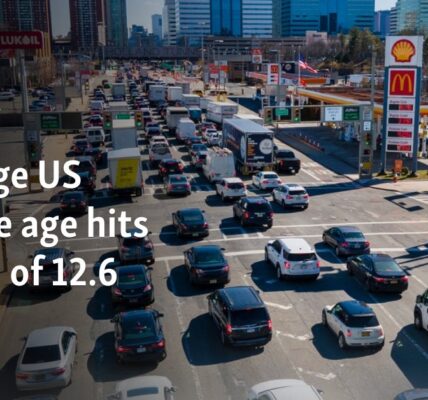The Chinese government released several economic indicators on Wednesday, showing that the economy is still facing challenges in recovering from the impact of the COVID-19 pandemic. However, it did surpass the conservative growth goal set by the central government.
In 2023, the Chinese economy experienced a growth of 5.2%, as reported by the National Bureau of Statistics. However, this news also revealed that the country is still facing issues such as consistent deflation, a continuing crisis in the real estate market, a high rate of youth unemployment, and a decline in population over the long term.
The economic information was made available shortly after a report showed a 4.6% decrease in China’s exports in 2023, marking the first year-on-year drop since 2016.
The government tried to present the data in a positive light by stating that the overall economy showed signs of improvement, with steady improvements in supply and demand, advancements in upgrading and transformation efforts, stable employment and prices, effective guarantees for people’s well-being, progress towards high-quality development, and successful achievement of major targets.
Despite this, the financial markets remained unconvinced. On Wednesday, prominent stock indexes monitoring Chinese companies experienced a significant drop, with the Hang Seng China Enterprises Index declining by almost 4%. This index has decreased by 11% since the end of 2023 and by 27% compared to the same time last year.
Low target
Prior to the data’s release, Chinese Premier Li Qiang made a statement at the World Economic Forum in Davos, Switzerland, stating that the government’s growth target of approximately 5% had been surpassed in 2023. However, according to experts interviewed by VOA, the government had set a low bar for achievement.
According to Tianlei Huang, a research fellow and coordinator at the Peterson Institute for International Economics, the initial target was relatively low. He pointed out that as of 2021, the economy was still growing at a rate of over 8%.
Economists predict that China will struggle to maintain the same rate of growth as seen in 2023 this year. According to the World Bank’s most recent forecast, Chinese economic growth is expected to slow down to 4.5% in 2024.
According to Huang, there were positive indications. One of them being that the average household expenditure on goods and services increased at a higher rate compared to household disposable income, indicating a rise in demand.
Huang stated that there is also proof indicating that, despite the government’s claims of strong economic growth, Chinese citizens are doubtful about what lies ahead. He mentioned that this sentiment is reflected in the increasing amount of money being deposited into low-yield bank savings accounts.
“This situation is particularly confusing as interest rates for deposits in China are decreasing,” stated Huang. “This means that individuals are now saving more money in bank accounts despite receiving lower returns. This demonstrates that households are still anxious about their job security and future income.”
Deflation continues
On Wednesday, the data revealed that consumer prices in China decreased for the third month in a row in December. This was despite the People’s Bank of China’s efforts to lower interest rates in order to encourage spending and boost prices.
Although it may appear beneficial for consumers, continuous deflation can have a detrimental impact on the economy by decreasing the motivation for businesses to increase production of goods and services. This, in turn, can lead to negative consequences for economic growth and employment rates.
The Chinese government has displayed conflicting indications regarding its plans for economic stimulus to boost demand and combat deflation. According to a report from Bloomberg on Tuesday, Chinese officials are considering issuing bonds worth 1 trillion yuan (equivalent to $139 billion) as an additional form of stimulus.
Real estate woes
The real estate industry in China is still facing challenges, as several major development firms are facing significant financial difficulties and the prices of real estate are dropping rapidly.
Over the past year, numerous prominent real estate companies have struggled to make bond payments and have even defaulted. This has resulted in construction delays for customers who had already paid for apartments, with no guarantee of when work will resume. As a result, Chinese citizens are now more hesitant to invest in property, and this hesitation is also evident in the commercial real estate market.
Compared to the previous year, there was a 9.6% decrease in investment for real estate development. The total area of commercial real estate sold decreased by 8.5%, and the overall monetary value of commercial real estate transactions dropped by 6.5%.
New unemployment figures
In the beginning of this year, the Chinese government announced that unemployment rates for young Chinese had risen to over 21% in June. As a result, Beijing stopped releasing this information. The government stated that they needed to enhance their methods for collecting and measuring data.
The report released on Wednesday showed a significant decrease in youth unemployment numbers, dropping to 14.9% from its previous level six months ago.
The decrease can be attributed to the type of information that the government now selects to monitor. Previously, students who were searching for part-time jobs but could not secure them were included in the unemployed category. However, currently, only those who are not enrolled in school or have already completed their education are considered unemployed.
Population decline
China’s current economic struggles are compounded by a concerning demographic pattern that poses a threat to the country’s future growth. After decades of steady increase, China’s population has started to decrease, as evidenced by data from 2022 and 2023.
China’s population decreased by 2.09 million in 2023, bringing the total population to 1.41 billion. The country experienced 9 million births, however, this was surpassed by 11.1 million deaths. The birth rate saw a decline of 500,000 from the previous year, continuing a trend seen over multiple years.
In the period from the 1980s until 2015, the Chinese government implemented a policy that restricted families to having only one child in order to control population growth. Although there was a slight increase in births in 2016 following the removal of this policy, birthrates have since decreased significantly and are currently at record lows. These rates are even lower than those seen in the early 1960s during a severe famine in China.
Thus far, attempts by the Communist Party to promote a higher birth rate among women have not been successful. Experts in population trends suggest that in order for a population to maintain stability, women should have an average of 2.1 children. However, China’s current birthrate is only half of this “replacement rate” and does not show indications of increasing in the near future.
Source: voanews.com





